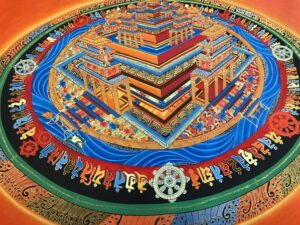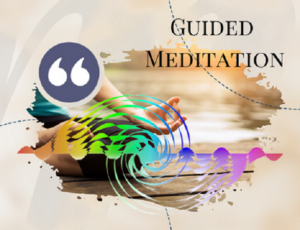According to Bhagavad Gita, the preeminent authority on all things Krishna, there are two possible explanations for the state, or phenom, known as Krishna Consciouness.
Central to the story of the Gita is a warrior prince named Arjuna. Krishna was his Guru, his chariot driver. I believe that Arjun was already established in Krishna Consciousness by virtue of this fact. He’d already given control of his mind to the Lord. He knew Him. Krishna was his most trusted confidant and friend.
At the same time, I believe there’s also the perspective that says Arjun didn’t achieve Krishna consciousness until that point when Krishna revealed his true, omni-form, the Viswarup, completely to Arjun’s sight. A one in a billion revelation as the legends go.
The Significance of Chariot Imagery
The Bhagavad Gita is central to the epic Mahabarata, a tale of a divided family going to war against one another. Central to the teachings in the Gita is the chariot driven by Krishna and Arjuna. The image is a pictorial metaphor for the human meta-psychology representing the inner instruments of mind and sense by which we guide our bodies through the life. The chariot is symbolic of the body, sarira in Sanskrit.
Jiva, the embodied individual soul, is represented by Arjuna, the passenger, while the position of charioteer is given to Lord Krishna who symbolizes the atma, often referred to as Self, higher intellect or Buddhi. He leads the chariot onto the battlefield at Kurukshetra, into the middle of two armies. On the one side are the Kauravas a.k.a. the demonic nature of mind, and on the other side of the field are the Pandavas, a.k.a. the divine nature. It’s the battle of mind which is being fought here; the reins of the horses are the operations of that mind, while the horses themselves, called indriyas and most commonly understood to represent the five senses. In further esoteric teaching, the horses may represent various emotions, attachments or hinderances to spiritual development such as the tendency to greed or lust. The chariot is guided along the various roads of life through a collaboration of higher intellect, senses and mind.
In this battle that rages daily within us, our Charioteer (God, Self) is forever on the side of dharma or righteousness, the reality which sustains, rather than the delusion which undermines. The Lord is ever where dharma is. The Bhagavad Gita is the story of learning to trust our higher intuition in the drive toward perfection, in other words, Self-realization, peace and enlightenment.
A concise listing of components of the issue has been provided in the ‘Teachings of Sri Sathya Sai Baba’ which I have described briefly below while also taking some minor liberties to amend grammar, vocabulary and punctuation somewhat.

Learn How to Drive Your Chariot
1. Chariot: Sarira (Physical Body), the instrument through which the Self, intellect, mind, and senses operate.
2. Charioteer: Atma (Self, Higher Intellect or Buddhi), is the wise giver of instructions to the mind.
3. Passenger: Jiva (the Soul, the embodied Atma, the center of consciousness), is always the neutral witness.
4. Horses: Indriyas (Five Senses), through which we relate to the external world by perception and action.
5. Reins: Manas (Mind), through which the senses receive their instructions to act and perceive.
6. Roads: The countless objects of senses and desires in the present world and within our memory.
7. Wheels of the Chariot: Right effort
8. Destination: “Perfection” or “Self Realization”
9. Kurukshetra: The battlefield of mind, the only place where one can confront, do battle with, and vanquish the inner demons.
10. Two Armies: Kauravas (Demonic Nature) and Pandavas (Divine Nature)
“Who’s driving your chariot? We don’t often let the charioteer on duty. The reins (mind) are flapping around freely without the proper inner guidance and not giving instruction to the horses (senses). Hence they wander freely down any road they feel like in response to their past memories (Chitta). The chariot (body) takes a beating, the horses (senses) get tired, the reins (mind)) get worn, and the charioteer (intelligence) gets lazy. The passenger is completely ignored.
The solution to the problem is to retrain the charioteer (Intelligence) to pick up the reins (mind) and start giving some direction to the horses (senses). This training is called sadhana (spiritual practice). It means training all of the levels of ourselves so that we might experience the still, silent, eternal center. Put the charioteer back on the job. Allow the charioteer to serve the passenger. As the charioteer (Intelligence) becomes more stabilized in being back on the job, there is an ever increasing awareness of the fact that the entire purpose of the chariot, horses, reins, and charioteer are to serve as instruments for the passenger, the true Self.
Don’t drive the car with your foot on the brake, but use the brakes to control the car when necessary. One must exercise some control when there is danger. If you don’t have any brakes at all you will surely come to grief. A chariot which cannot be brought under control like horses without reins, a car without brakes or a person without sense control, are all extremely dangerous and heading for disaster.”
The above quote by Sathya Sai, or his fellowship, is for the most part unassailable. However, I’d like to point out that if the Higher Self, Atma or Higher Intellect is represented by Krishna, the God-head, then it does not seem entirely justified to term that very same source as ‘becoming lazy’. I would sooner acknowledge the chariot itself to be falling into a state of disrepair and perhaps the passenger to have lost some sight of reality and therefore certainly incumbent upon him to bring the Lord back into central view, for benefit all around.

…is a Saiva Tantrika, Gyana Yogi and founder of Uma Maheshwara Yoga & Ayurveda. David has an MA in Semiotics, lives in Japan with his family and works as a coach in L & D, devoting his time to developing science-based tools and programs that help people reach the fullest potential of the human condition.
Discover more from REAL YOGA
Subscribe to get the latest posts sent to your email.









